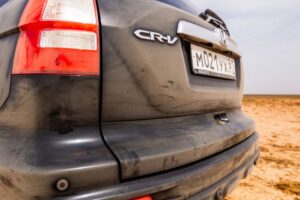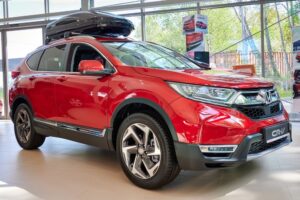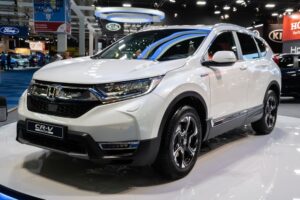For the past 20 years, the CRV has been Honda’s most popular and best-selling SUV.
It has been in production since 1997 and is currently in its 5th generation. Despite that, there is a moderate chance that once you try to start your CRV, it just will not budge.
After that, you may wonder “Why won’t my Honda CRV start?”. There are numerous factors for this. I have mentioned and discussed the top 7 in this article.
To get a satisfying answer to that question, here are some of the reasons briefly mentioned:
- Inadequate Fuel
- Drained/Dead Battery
- Failed Alternator
- Ignition Switch Failure
- Clogged Fuel Filter
- Interrupted Power Supply
- Poor Spark Plugs
Let’s get into the remainder of the article and learn more about each of these reasons, their severity and intensity, and what you can do to solve them.
Table of Contents
- 1 What Would Cause A Honda CR-V To Not Start?
- 2 Frequently Asked Questions
- 2.1 Q1. Why Won’t My Honda CR-V Start With New Battery?
- 2.2 Q2. Why Won’t My Honda CR-V Start Even With A Jump?
- 2.3 Q3. Why Won’t My Honda CR-V Start But Lights Work?
- 2.4 Q4. Why Won’t My Honda CR-V Start But Cranks?
- 2.5 Q5. Why Won’t My Honda CR-V Start Just Clicks?
- 2.6 Q6. Why Won’t My Honda CR-V Start In The Cold Weather?
- 2.7 Q7. Why Won’t My Honda CR-V Start After I Get Gas?
- 2.8 Q8. Why Won’t My Honda CR-V Start But Radio Works?
- 3 Conclusion
What Would Cause A Honda CR-V To Not Start?

In this section of the article, I will discuss each of the seven problems listed previously and explain why each of them stops the SUV from starting and how you can stop that from happening.
Some problems are more easily fixed, while others may require more time and money.
Either way, it is better to have regular maintenance on your Honda CRV to avoid all of these problems and to enjoy your SUV to the fullest without any major disruptions.
1: Inadequate Fuel Supply
If the energy supply is not there, what will the vehicle do about it? It does not matter how good your Honda CRV’s condition is. If there is no fuel in the tank, it will not start.
The fuel is the food supply of any vehicle. It is essential that your car never experiences hunger, or else it will break down continually, which can even shorten its life expectancy.
You probably will have gotten an indicator light turned on in the dashboard telling you your gas tank is empty.
So, if you choose to ignore that or even if that part is faulty, your CRV will, unfortunately, face this problem.
Driving close to the empty tank is also dangerous, as your car may break down in the middle of nowhere with no help in sight.
It also causes more stress on the engine as you force it to work even though it has no fuel, which is its food.
Continually doing this can be very dangerous for the health and life expectancy of the engine and the entire vehicle.
What Should You Do About It?
- If you are unsure whether your fuel gauge is telling you the right amount of gas left, go to the nearest gas station and verify it.
- In any case, make sure to fill up your gas tank with quality, reliable fuel.
- Make sure that the fuel never depletes as that can also be very harmful to the engine.
- Keep extra petrol with you if the CRV breaks down in the middle of nowhere because of lack of fuel.
2: Drained/Dead Battery
The battery is the most important part of any vehicle when starting it. So not having it fully charged will result in failure start.
If this problem is the case with your Honda CR-V, you will have experienced a very clumsy and slow starter, as it exerts more power and stress on the engine to start the car.
If the battery is completely drained, you will hear a clicking sound from the magnetic switch to cause that sound.
This is because the battery still has enough voltage to cause this, which dips afterward, making the clumsy sound at the end of the clicking sound.
Apart from that, the corrosion of battery cables and terminals is also a leading cause of defecting the battery.
Even if the battery produces enough charge, it might not be able to hold it and deliver it to the engine.
In addition to a broken alternator, this scenario has suddenly become the worst nightmare for any car owner.
If not checked on time and properly, you might even have to get your engine replaced. And that is a headache so expensive. It is best if you try your best to avoid it.
What Should You Do About It?
- Use jumper cables to provide a pulse of current from another vehicle to charge the battery.
- Start boosters can be used, as they are much quicker than using jumper cables.
- Alternatively, an alternator can be used too. This recharges the battery the moment the engine ignites.
- You will have to replace the battery if none of the above are working.
- Get your battery replaced every 3 to 5 years for your Honda CRV.
- Check cables and terminals of the battery. If they are loosened, tighten them up, and if they are corroded, rusty, or defective, get them replaced as soon as possible.
3: Failed Alternator
Alternator supplies electric current to the car’s various components. The battery only gives an initial kick start.
After that, the alternator is responsible for keeping the engine going. So, a bad alternator will not only cause the car to break down but also fry its other electrical components.
Furthermore, a faulty alternator can cause the battery to be drained faster, which can cause other problems that you would have to deal with that come with a drained battery.
If jump cables are unavailable, your Honda CRV would need to be towed to the repair shop or dealership to get fixed.
It is a relatively cheap and quick fix for an alternator. However, it can be a nuisance and big headache if not taken care of in time.
What Should You Do About It?
- If the damage is not that serious, get your jumper cables out. The chances are that a quick and easy jump cable fix would suffice, saving you time and money from going to the mechanic.
- If jump cables are not adequate, you will need the help of a proper mechanic for this one.
- It requires the usage of certain professional tools, depending on the degree of damage done.
- In most cases, however, the alternator ends up being replaced altogether.
- Make sure that whatever repairs need to be done are done as soon as possible. Otherwise, you may also need to replace the battery, which will cause you even more expenditure and headache.
4: Ignition Switch Failure
Sometimes you may see that even though you are turning on the ignition key, the engine is not reacting.
If you do not even hear the engine cranking, the probable cause of this can be faulty ignition electronics.
For the Honda CRV, there may be an issue with a chip inserted in the key (for non-traditional ignition locks).
Your AC, radio, and headlights might work, though they would likely flicker and fluctuate, and the engine will not start.
Even more terrifying is that the ignition switch could fail while driving.
So, if you thought that the ignition switch of your Honda CRV has failed, immediately contact your local repair shop and/or mechanic and get it fixed.
What Should You Do About It?
- A jump start will not suffice here.
- The best action is to take your Honda CRV to the dealership or your mechanic and get them to do the repairs.
- Most likely, it would need to be fully replaced.
- If the problem is due to this, it has to be replaced. There is no other option.
5: Clogged Fuel Filter
Filters need to be cleaned and changed throughout the car. Different milestone miles are prescribed to different filters for their changing.
In the case of the fuel filter, it needs to be replaced every 20,000 miles, according to Honda.
A clogged fuel filter will cause a spluttering sound in the engine and inhibit the engine from getting started.
The fuel filter is responsible for keeping all the unwanted debris and dirt out of the fuel system so that the engine does not get any sort of blockage.
Cleaning the fuel filter or even replacing it is not that big a problem.
So, get it done regularly to avoid your Honda CRV from breaking down and then not even starting back up, especially in the middle of traffic, or worse, in the middle of nowhere.
What Should You Do About It?
- Fixing a clogged fuel filter is a relatively easy and cheap fix.
- But still, it is better to get it checked by a mechanic.
- The likely scenario is that the fuel filter would require a simple cleaning.
- However, if its time has come, i.e., every 20,000 miles, it needs to be replaced.
6: Interrupted Power Supply
Power can get generated in the battery in the right amount. However, if it is not delivered properly, it will not do you any good.
This can be caused by a plethora of reasons; the main ones being a blown fuse, oxidization of defective cables, damage to wires, loose cables, and many more.
All of the above are important equipment required to transfer the power around with minimal loss.
If the wires and cables are damaged, corroded, rusty, oxidized, or any other fault is in them, they will either not be able to deliver the power to the engine properly, or they might lose power in such huge amounts that the result delivered to the engine is not sufficient for its ignition.
Even loosened cable connections can cause this.
Be wary of leakage in this scenario as access leakage of current and voltage can cause severe damage to the engine and vehicle, possibly injuring you or even being fatal.
What Should You Do About It?
- Make sure all the required connections are present in the engine.
- Replace any blown fuse, and do not start the car until all further repairs are completed.
- Then check whether the cable connections, especially the battery terminals, are properly tightly connected and in the right order of positive and negative.
- If any cables or wires defect in any way possible, get your local mechanic to change all damaged cables and wires immediately to prevent any excess leakage and damage to the SUV.
- If still there is a problem, get the ignition coil checked.
7: Poor Spark Plugs
Spark plugs provide – as is in their name – a spark that pushes the engine to ignition. It is an essential part of the ignition phase of any vehicle.
Defective spark plugs are one of the most common reasons your Honda CRV is malfunctioning and not starting.
This can be due to many reasons, the most common being the SUV being exposed to direct cold weather for many hours or not being replaced in time.
Spark plugs need to be replaced every 30,000 miles. High-quality spark plugs can last up to 100,000 miles, though that is rare.
For the engine to work properly, spark plugs must be replaced after their specified interval.
What Should You Do About It?
- Get those spark plugs replaced if they have not been for 30,000 miles or are too far beyond repair.
- Unfortunately, even if it is not something major, spark plugs can rarely ever be fixed. More or less, they have to be replaced.
- Fortunately, however, spark plugs are cheap and easily available components. Furthermore, they can also be changed pretty quickly. So, all in all, it is not that hectic of a situation if spark plugs need to be changed.
Frequently Asked Questions
Q1. Why Won’t My Honda CR-V Start With New Battery?

A new battery is not a guarantee of ignition. There are multiple reasons for this.
Mainly the new battery provided would be faulty.
This would most likely occur if you had bought a used car battery as a replacement.
However, the problem could also be a battery and another issue.
If the battery is fine, the blame would go to either the alternator (or electrical system) or lose connections.
In case the latter being true, ask your mechanic to go through the entire engine and tighten up any connections, especially those that have a link with the battery, and tighten them.
Q2. Why Won’t My Honda CR-V Start Even With A Jump?
As I have explained previously, if there is any issue with the battery, a jump start brings it back to enough health for the car to get started.
However, if it does not happen and the vehicle is still not igniting, we have a more serious problem.
If the battery is too far drained out, a jump start might not suffice. You need to contact your mechanic immediately and get them to check your engine as soon as possible.
Probably the reason for a jump start not working would be a completely dead battery, which is beyond repair.
Then the only course of action left is to buy a new battery and replace the dead one with it.
Q3. Why Won’t My Honda CR-V Start But Lights Work?
Lights, radio, air conditioning, etc., can work and turn on even if the engine is not.
This is because the battery does not have enough voltage left in it to deliver the necessarily required power for the ignition of the engine.
But it does have enough energy left to cross the activation energy barrier required for turning the lights (headlights, backlights, indicator lights, etc.) to be powered on.
Q4. Why Won’t My Honda CR-V Start But Cranks?
This happens because of multiple factors. Your car may be out of gas or have a faulty fuel pump. Fuel pumps need to be replaced after 200,000 or even 100,000 miles in a few cases.
If the pump is faulty, the fuel will not get pumped into the engine properly, and hence ignition would fail.
There may also be a fault in the fuel lines. A leak in this connection can prevent the fuel from getting into the engine properly. Fuel lines are also relatively easily affected by cols.
So, if your Honda CRV is in the direct cold for a lot of hours, as the whole night, then the fuel lines may even freeze, causing fuel to not reach the engine.
To prevent this, you would need to thaw out the system first. Try to park indoors away from the direct influence of the weather as much as possible.
Q5. Why Won’t My Honda CR-V Start Just Clicks?
This has most likely got to do something with the battery. The clicking sound is heard from the magnetic switch inside the starter.
Even when completely drained, the battery has enough voltage to cause the clicking sound to be heard, but it dips immediately afterward, and thus the Honda CRV does not start.
So, if you only hear a clicking sound but your engine is not getting started, you can confidently pinpoint the battery as the cause of the issue.
As this is a battery problem, a simple jump-start should do the trick.
However, if that does not work, go to your mechanic to get the battery looked at. The battery may even need to get replaced.
Just make sure if it does come to that, buy a brand new battery from a trusted and reliable source as the replacement.
Q6. Why Won’t My Honda CR-V Start In The Cold Weather?
Honda CR-V faces its bulk of battery problems in lower temperatures, i.e., winter.
In colder temperatures, the charging capability of the SUV is significantly impacted. It takes more energy to charge the battery in cold weather than in a hotter climate.
Cold weather will also affect the fuel lines, even freezing them.
This will again require more energy to get the fuel going, and the vehicle started, as some of it will have to be used for defrosting the fuel lines.
Spark plugs are required to fire up for ignition to happen. Naturally, this is inhibited by the cold weather.
Higher energy output will be required to cross the activation energy barrier for the spark plugs to ignite.
Q7. Why Won’t My Honda CR-V Start After I Get Gas?
The main problems here would lie with the battery, electrical components, and fuel delivery system.
Even after getting gas, if the battery is faulty for any reason (as discussed previously), the car will not start no matter what you do.
The same goes for the entire electrical system of the car. The circulation of electricity throughout the engine needs to be proper for the car to start.
After getting gas, you would expect the engine to not have a fuel deficit.
However, if the delivery system designed for the fuel is not working properly, what good would filling up the tank do.
The transport medium for gas to get to the engine is essential to be working if you want the fuel you fill up your Honda CRV with to actually benefit you and your vehicle.
Q8. Why Won’t My Honda CR-V Start But Radio Works?
Radio does not require that much power to work.
In fact, if you turn on your car, you will see that the radio turns on before the ignition occurs. This is because of the little energy and power required to do the task of turning the radio on.
If the radio is powered on, but the engine is not, that means the battery has gone weak.
The electrical output it is giving may be enough for the radio but not for the engine to ignite properly.
In that case, contact your mechanic and get them to inspect your engine.
If the fault turns out to be with the battery, getting a jump start would probably fix the problem if the battery is not too far drained out.
Related: What Are The Worst Years For The Honda CR-V?
Conclusion
The Honda CRV is not without its problems. In fact, it has many of them. Even after 27 years in the commercial market, various issues have plagued them.
Many of these problems are related to the fuel supply, fuel delivery system, electrical system, battery, alternator, and starter.
Each contributes in its own way by causing the CR-V to fail in starting.
After reading this article, I am confident that you will have at least some answers to your question of “Why won’t my Honda CRV start?”.
Every problem has a solution. It might not be an easy or cheap solution, but sometimes you need to go the extra mile for the maintenance of your vehicle.

I am Tahir Azam, and I have been writing amazing articles for TaxiHack for as long as I can remember. I know everything that is to know when it comes to automobiles and is always on top of industry news and developments. While I am not an expert by any means, I pride myself on knowing the ins and outs of many different problems and, of course, their solutions. The articles on our website are some of the best and well-researched content that you will find, and I spend countless hours making sure this remains to be true. This is why I ask you to take your time out and read some of my articles, especially if you find a topic that resonates with you or is something you are looking into. This way, you will find the perfect mix of information and tips on your desired topic. Learn more about Tahir.



